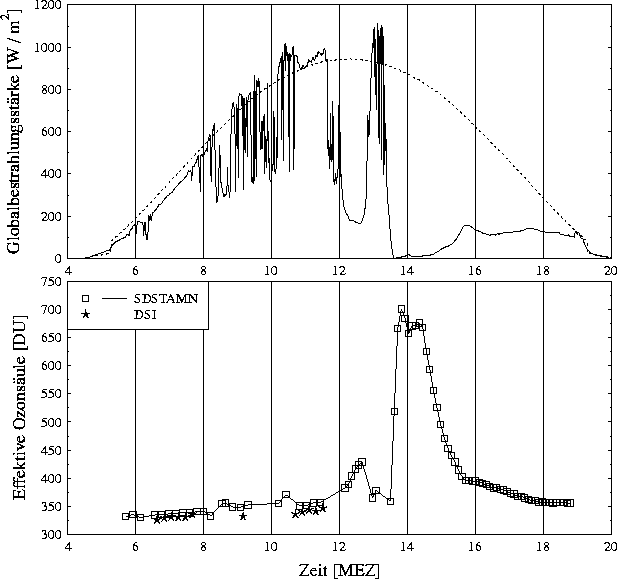Enhanced absorption in presence of thick clouds
Spectral irradiance, measured in presence of optically very thick clouds,
gave evidence for enhanced absorption by atmospheric ozone. Due to
multiple scattering inside a cloud, photon pathlengths may be increased
by factors of 10 and more. Enhanced photon paths lead to enhanced absorption,
resulting in an apparent doubling in total ozone during an optically
very thick cloud on June 19, 1994.

(Top) Diurnal variation of the total ("shortwave") irradiance
on June 19, 1994. Cloudless sky in the morning is followed by broken
cloudiness (note the enhancements of the irradiance compared to
the cloudless day which is shown as a dashed line). In the
afternoon, the irradiance is reduced by a factor of 100 due to the
presence of an optically thick thunderstorm cloud. (Bottom) Diurnal
variation of the "effective" or "apparent" ozone which is derived
using the method described by
[Stamnes et al., 1991], assuming
a wavelength-independent attenuation by clouds. As a doubling
in total ozone is far too much to be explained by ozone production
in the thunderstorm cloud, it indicates a strong photon pathlength
enhancement inside the cloud due to multiple scattering,
leading to more efficient absorption by ozone.
The qualitive results presented in the thesis were later
explained quantitatively by
[Mayer et al., 1998].
An important consequence of these findings is that total ozone,
derived from global irradiance or zenith sky radiance, is subject
to large uncertainties in presence of optically thick clouds; see also
[Erle et al., 1995]
References
- 1
-
Erle, F., K. Pfeilsticker, and U. Platt.
On the influence of tropospheric clouds on
zenith-scattered-light measurements of stratospheric
species. GRL,
22, 2725-2728, 1995.
- 2
-
Stamnes, K., J. Slusser, and M. Bowen.
Derivation of total ozone abundance and cloud
effects from spectral irradiance measurements. Applied Optics,
30, 4418-4426, 1991.

